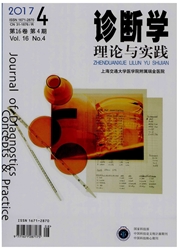

 中文摘要:
中文摘要:
目的探讨舌下神经降支-面神经吻合术在治疗听神经瘤术后并发重度面瘫的临床疗效。方法回顾性分析自2015年1月至2016年5月于山西医科大学第一医院神经外科收治的接受面神经吻合的患者6例,其中女性4例,男性2例,年龄26~65岁,平均年龄45.5岁,均为听神经瘤术后并发重度面瘫患者。术前、术后采用House-Brackman评分系统进行面神经功能评估,6例患者均行舌下神经降支与面神经吻合术,术后随访至少12个月。结果术后使用House-Brackman面神经功能评价系统进行评价:Ⅱ级的1例,Ⅲ级的2例,Ⅳ级的2例,Ⅴ级的1例。患者面部感觉均较术前提高,在静态时的面容对称除1例外,其余5例均较满意,而且其中1例眼睑可完全闭合,眼裂基本消失。所有患者均无同侧舌肌瘫痪,均无明显的的发音和吞咽功能障碍。结论舌下神经降支-面神经吻合术可以作为听神经瘤术后并发周围性面瘫的一种有效治疗手段。
 英文摘要:
英文摘要:
Objective To evaluate the effiency of descending hypoglossal branch-facial nerve anastomosis for the severe facial palsy after acoustic neuroma surgery.Methods The clinical data of 6 patients(2 males,4 females,average age 45.5 years old) underwent descending hypoglossal branch-facial nerve anastomosis for treatment of unilateral facial palsy was analyzed retrospectively.All patients previously had undergone resection of an acoustic neuroma.House-Brackman grading system was used to assess the pre-,post-operative and follow up facial nerve function status.The patients were followed up for at least 12 months.Results According to the House-Brackman facial nerve function evaluation system,1 case is Ⅱ grade,2 cases are grade Ⅲ,2 cases are grade IV,1 case is Ⅴ grade.Patients with facial sensations were improved compared with preoperative.In the 6 patients,5 patients had satisfactory facial symmetry,and one patient could close the eyelid,and the eye crack almost disappeared.All patients had no paralysis of the ipsilateral lingual muscle and no obvious pronunciation and swallowing dysfunction.Conclusion Descending hypoglossal branch-facial nerve anastomosis is effective for facial reanimation.
 同期刊论文项目
同期刊论文项目
 同项目期刊论文
同项目期刊论文
 期刊信息
期刊信息
